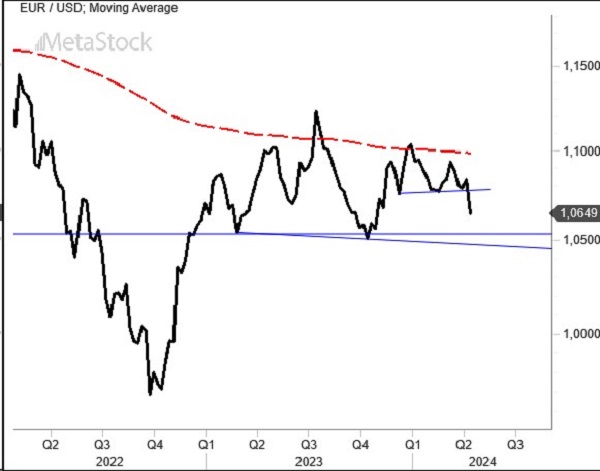- U.S. Inflation Surprises: Annual U.S. inflation has climbed past forecasts, exceeding 3%, leaving open the possibility of at most two interest rate cuts in 2024. However, as the upcoming election looms, the market is beginning to believe that no moves will be made.
- ECB Holds Steady: The European Central Bank has kept rates unchanged as expected, confirming that future inflation data will guide interest rate decisions from June onwards. Market sentiment suggests a rate cut may be near.
- EurUsd Breaks Lower: The currency pair has decisively broken below key support levels, formalizing a bearish pattern with a target of 1.05.
- Meanwhile, the winds of war are blowing strong in the Middle East.
March U.S Inflation Fuels Economic Uncertainty Amid ECB Caution
March’s eagerly awaited U.S. inflation data showed a significant rise, particularly in petroleum products, setting the stage for an increase in the headline CPI to 3.5%. The core rate, stripped of volatile components, exceeded expectations at 3.7%. Recent remarks from central bankers, focusing largely on unexpectedly strong economic growth, have revived the entire yield curve, with the 10-year U.S. Treasury note reaching 4.5%.
Expectations of a rate hike in June have been squashed, and it’s increasingly likely that nothing will happen for the rest of the year given the imminent election. Under these conditions, the market is pricing in inflation levels well above 2% for the coming years, bolstering those who argue that this year will see few cuts in the cost of borrowing, thereby supporting a bullish outlook on the dollar.
Minutes from the latest Federal Reserve meeting highlighted the uncertainty among U.S. bankers, hesitant about what steps to take in the face of continued robust economic growth. Meanwhile, the ECB has decided to keep rates steady, affirming that data from now until June will shape the contours of future monetary policy moves. Recent German industrial production data showed a slight recovery with a monthly increase of 2.1%, though tempered by disappointing export figures down 2% in March. Rising oil prices due to Middle Eastern tensions and the resulting depreciation of the euro could disrupt the ECB’s plans.
Technical Analysis – Sudden EurUsd Volatility Signals Key Bearish Shift
Volatility on EurUsd, which had seemed to be a fading phenomenon with movements becoming increasingly muted, has abruptly intensified, violating levels often in an unexpected burst of volatility. This past week is a testament to this fact, with the Bollinger bands, not this tight since 2019, suddenly experiencing a downward movement, indicating a bearish break by EurUsd.

This situation unlocks a surprise move in EurUsd, considering that seasonality would typically be against the dollar. The weekly chart clarifies why. On the upper level, the 200-week moving average (currently at 1.10) has thwarted any bullish initiatives, with only a false signal in the summer of 2023 misleading about an early euro rebound. Looking downward, it’s clear that the 1.05 zone represents another significant technical step to overcome for a greenback that has just formalized a bearish head and shoulders pattern, breaking through the dynamic support offered by the 200-day moving average. What happens around 1.05 will now be of great interest, a crucial technical step also strategically for the EurUsd exchange rate.



Leave a Reply
You must be logged in to post a comment.